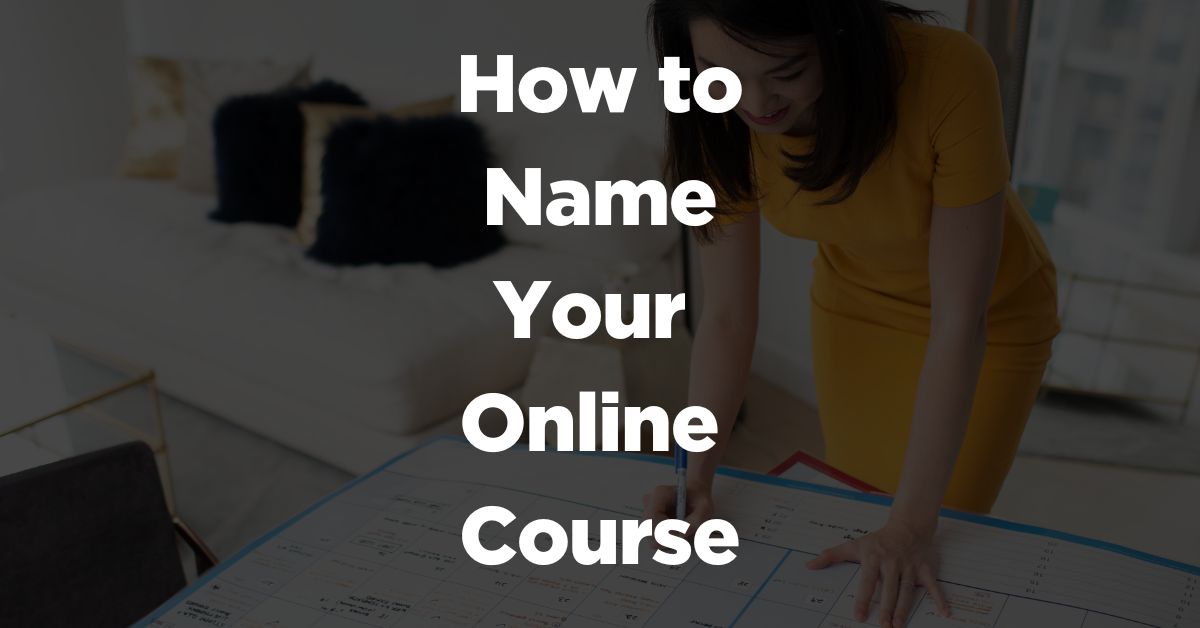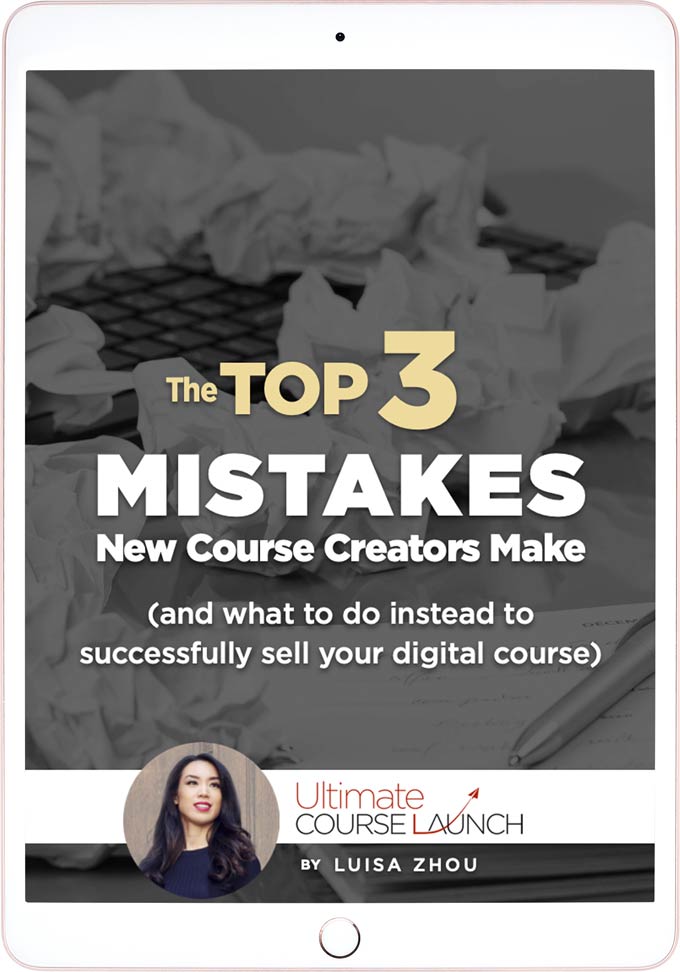Wondering how to name your online course? That’s what we’re going to talk about in this article.
Choosing a memorable name is important because it’s more likely to…
- Stick in people’s minds
- Increase interest in your course
- Boost sales
But what are the steps to choosing an effective course name for YOU? Keep reading… You’re about to find out.
How do you name your online course?
Here are a few things to think about when you’re considering different options…
First of all, as I briefly touched on already, your course name should get people interested in your course.
In other words?
They should read your course title and want to know more about how you can help them.
Because if you can peak their interest, they’ll be WAY more likely to want to buy from you.
Let’s look at some examples of course names that work:
For my own A-Z course, I decided to call it “Employee to Entrepreneur” (ETE).
So… as you can probably tell from the name, this course is all about helping people who are currently employees break free from their day job and become successful entrepreneurs.
And that’s one of the things that makes it so effective…
Just by reading the course name, people already KNOW what it’s about. And if they’re feeling stuck in an unfulfilling job, that name can be enough to peak their interest and get them to find out more.
Here’s another example…
One of my students, Emily, chose to call her courses “Happily Hired.”
Again, this name works really well because it perfectly describes what Emily offers and what people can expect if they take her courses.
And THAT is really powerful.

Alright, now that you’ve seen a few examples, let’s talk about the steps you can take to come up with a great name for your course… Even if you’re currently stumped.
1. Understand your audience
Listen: No matter what your course is about, people will come to you based on your ability to solve their problems.
So… What problems do people have that your course can solve?
This is a super important question.
Why?
Because it will help you pinpoint exactly WHO you’re going to help and what problems you’re going to help them with.
And once you know that, it’ll be WAY easier to come up with an effective name for your course.
For example, one of my students is a dating coach for men, so she creates online courses that speak to her own target audience and their specific pain points.
She has courses with names like “Reducing Overthinking in Dating” and “Overcoming Negativity in Dating.”
Because she’s identified who she’s talking to (single men looking for a serious relationship) and what they struggle with (moving past disappointing dating experiences), she’s able to name her courses so they speak to the specific audience she wants to help.
But this concept works for any niche or topic…
To name your course effectively, first figure out what problem your potential customers have that you can solve. And then make it abundantly clear that you can solve it for them.
So, let’s look at an example.
One of my courses is called “My First 10k Subscribers.”
Basically, this course helps guide people who don’t know how to grow an email list (which is their problem) using the exact steps I took to gain over 10k email subscribers and $1.1 million in under a year (which is the solution I offer).
Okay, but maybe you’re thinking, “I have an idea for a course, but… I don’t actually know if people would be interested or not.”
In that case, I recommend that you start off by providing coaching or consulting services BEFORE trying to sell a course.
Let me explain…
When you coach people, you’re able to see up close what they struggle with, ask them questions, and identify patterns that can help you create an amazing course later on.
For example, let’s say you’re an entrepreneur who wants to sell a business-related course. The only thing is, you’re not sure what angle to focus on or who you’d help exactly.
In that case, you could offer to coach a few would-be entrepreneurs for a reduced rate.
And here’s where identifying patterns comes in…
Through coaching, you might realize that almost everyone you talk to says they struggle with something you’re already good at, like networking as an introvert.
With that insight, you can create a course that speaks to people with those specific pain points, like introverts who struggle putting themselves out there.
Basically, as a coach, you’re paid to do market research.
And that is GOLD.
Because once you really understand your audience, it’ll be way easier to structure your course and create course content so you can deliver the best results possible.
I talk more about this here:
Another way to come up with great course titles?
Look at the benefits. Here’s what I mean by that.
2. Focus on the benefits
What results or transformation does your course offer? That question can be the key to finding a great course title.
OK, let’s talk about that…
For a course to be worth investing in, you have to offer some end result that people WANT.
And once you’ve figured out what that end result is, you can choose a name that makes people think of that ultimate end goal they’re after.
Because here’s the thing…
People don’t care about HOW they’re going to reach their end goal.
In other words, they don’t care about what features you include (or don’t include) in your course. What they want is the transformation you promise.
Ultimately, that’s what they’re after. The rest is just detail.
So, with that in mind, a great option is to use your audience’s goals in your course title.
How?
Here’s a famous example: Tim Ferris’ book, “The 4-Hour Workweek” speaks directly to people who want to work less and have more freedom to do what they want with their time.
And again, just by looking at the title, it’s clear what the book is about and who the target audience is.
3. Make it relatively short
Look: Super long online course names are hard to remember. Which means? They’re not as effective as something short and snappy.
So, when you’re thinking about different options, keep this in mind.
Ideally, you want to aim for a course name that’s 2-4 words long.
This is a good middle ground between making it so short that you can’t describe what your course is about, and so long that people forget it almost immediately.
4. Make it clear
Clarity is king, as the saying goes.
In other words, people should be able to understand what your course is about by reading the title. If it sounds clever but doesn’t make a lot of sense, it’s probably NOT your best option.
In fact, according to several studies, brands that use unconventional spelling for common words (like Lyft vs. Lift) can come across as less sincere.
So, bottom line: When in doubt, stick with something that’s easy to understand.
5. Use SEO keywords (if possible)
Ideally, use search engine optimization to pick a course name that will help you rank in search engines.
How? By using search terms that people use when they’re looking for solutions to their problems… Solutions that YOUR course offers.
Let me explain…
Often, people don’t do a Google search looking for a course specifically.
But if you use keywords that your target audience is likely to use, that can help you rank higher in search results and ultimately get found by more people…
And much more importantly, the RIGHT people.
Again, my ETE course accomplishes this because people who want to become entrepreneurs are more likely to use search terms like “how to go from employee to entrepreneur.”
This is called “search intent” and it means what people are looking for when they do a search.
So, for example, if someone does a Google search for “bakery near me,” Google’s algorithm will offer related searches that might be relevant to what the person is looking for, like “vegan friendly.”
As a course creator, you want to do the same thing and use keywords that people who need what you offer are also using.
To find those keywords, do a bit of keyword research using Google Keyword Planner. Just a tip: Don’t stare yourself blind at the search volume (the number of people searching for that keyword. Instead, look for keywords that are as targeted as possible.
6. Make it easy to remember
Remember how I said that choosing a memorable course name is the way to go? Alright, let’s talk more about that…
Sometimes, people come across a course that interests them. But… for whatever reason, they’re not ready to buy it right then and there.
This is especially true if the course represents a huge financial investment for them.
Here’s the thing, though…
If you name your course something that’s easy to remember, it’ll be MUCH easier for people to find it again when they’re actually ready to buy from you.
So, for example, one of my courses is called Clients Come to Me (CCM), which tends to stick.
And ultimately, that’s what you want.
7. Differentiate between “first steps” and A-Z courses
Here’s another important thing to consider when you’re thinking of how to name your online course: The TYPE of course you’re creating matters.
Let’s talk about that…
For example, my “first steps” course is called “Clients Come to Me” which is focused on one aspect of having a successful business.
So, just by reading the name, people know that the course is pretty niche and won’t cover everything there is to know about starting a successful business from scratch.
This is in contrast to my A-Z course “Employee to Entrepreneur” which really is the full package deal.
In each case, the name reflects what’s being offered.
This is key because you don’t want people to buy your course expecting something specific and then be disappointed.
Make sure you always make it clear what your course offers and what results people can expect.
8. Check trademarks
In some cases, a name or phrase can be trademarked… Which means you can get into legal trouble if you use it for your course without permission.
But don’t worry, there’s a way to check for trademarks to make sure you can use your course name without any problems.
When in doubt, just do a search in the Trademark Electronic Search System (TESS). It’s always better to check this early on to avoid surprises, so don’t skip this step.
Alright, up next – let’s talk about how to nail your course name using a formula.
The ultimate formula for naming your online course
Here’s the foolproof formula you can use to define your niche and pinpoint exactly how your course can solve people’s problems:
“I help___ to ___ so that ___.”
Okay, let’s take a random example…
You could say, “I help college students to start a profitable side hustle so that they can graduate debt-free.”
But again, that’s just one example… You can adjust this formula in whatever way makes sense for your course(and I’ll talk about other formulas too in a minute).
So, once you know who you’re trying to help and what problem you can solve for them, you can play around with a course name generator to come up with name ideas based on your niche.
For example, on Thinkific, you can enter a few words that relate to your course, and it’ll automatically generate name ideas based on your input.
So, I tried it out.
In the course description field, I put a random idea: “A course for college students who want to start a business.”
And here are a few results I got:
- Launch Your Own Venture: A Guide for College Students
- From Campus to Company: Building a Business as a Student
- Startup Academy: Launching Your Business in College
I also searched using Sell Courses Online with the query, “website SEO optimization”.
For this search, a few results included:
- SEO Power: Unlock Your Website Potential
- SEO Mastery in 30 Days
- The Complete SEO Bootcamp
As you can see, course name generators can give you decent results.
So, bottom line: First, use the formula I talked about to zero in on what specific problem your course can solve.
And once you’ve done that, you can use handy AI tools to come up with a name that works. But remember, these tools can be a starting point… You don’t have to pick something that’s AI-generated.
If you’re feeling stuck, though, they CAN help point you in the right direction. (And I’ll talk about more tools you can use a little later).
Alright, I said I’d talk about other formulas too, so here are a few ideas that can also be useful:
Formula #1: Do [blank] to get [blank]
Remember how I talked about how you should focus on the end result your course offers right in your title? Well, you can use this easy formula to help you do that:
[Verb] and [benefit your course offers]
For example, if your course is about scaling a business for people who want to have more free time, you could use this formula to come up with a name like “Scale Up and Work Less.”
Formula #2: From here to the end goal
What transformation does your course offer? In other words, why should someone choose YOUR course? What goal are you going to help them attain?
Here’s a formula that can help:
[Beginning] to [desired end result]
I used this formula for my “Employee to Entrepreneur” course. Basically, this works really well because it gives people a vision of where they could end up if they took your course.
Formula #3: Focus on ease
People want things to be easy, so they gravitate toward course names that promise ease. For example…
- [Blank] Made Easy
- Easy Hacks for [blank]
- The Foolproof Guide to [blank]
…You get the idea.
Okay, up next: Let’s take a look at more tools you can use to generate course names.
The best online course name generators
ChatGPT
It’s hard to beat ChatGPT, whether you’re planning your next vacation or need help choosing a gift… And unsurprisingly, it can even help you name your course.
For example, I asked ChatGPT to help me come up with a short name for a course that helps teens start a business. And here are a few options it gave me:
- TeenBiz Launch
- Teenpreneur Edge
- StartUp Teens
Play around with it and see what works for you!
Ahrefs
Like with ChatGPT, you can use this tool to type a short description of what you need (e.g. “A name for a course that helps teens who want to start a business”) and even choose what writing tone you’re looking for (e.g. formal, friendly, casual, etc.).
Randomwordgenerator.com
If you’re looking for power words to incorporate into your course name, try a random word generator. Here, you can filter by things like word type (nouns, verbs, adjectives, etc.), the first and last letter, and syllables.
Okay, next, let’s talk about some great course names – and WHY they work.
Top course name examples
Alright, I’ve already talked about some of the following course name examples, but let’s go over a few more and briefly talk about what makes them effective.
Some of these are mine, and some are courses my students created.
Course name: Employee to Entrepreneur (ETE)
Why it works: It’s short and effectively describes what the end goal students can achieve is.
Course name: Happily Hired
Why it works: People immediately know what pain point the course can help them with, and it’s easy to remember.
Course name: Character Lighting for Animated Films
Why it works: It’s descriptive – without being too long.
Course name: Career Redefined
Why it works: It speaks to a specific audience (people who are unfulfilled in their current job) and makes it clear what the end result of taking the course would be.
Okay, what’s the bottom line here? Ultimately, no matter what your course topic is, having a clear, short title is the way to go.
And if you want to learn more about how to create an online course, watch this short video:
Next steps
So, there you have it! Now you know how to name your online course and what tools you can use to make the process easier.
As you can see, choosing the right name is important because it’ll help you attract the right audience and ultimately sell more.
But what if you need more guidance as you create your course? I’ve been there…
That’s why I created a free PDF to help you avoid the top three mistakes people make when selling an online course.
Read more:
How to Launch Your Online Course (+ Checklist)
Online Course Design: How to Design a Remarkable Course
How Long Does It Take to Create an Online Course?








